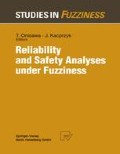Abstract
The main aim of this paper is to show how lattice theory in the very next future will be a useful tool in analysing complex real reliability problems, not properly modelled within classical reliability theory. The introduction of a complete lattice as a state space appears not only of theoretical importance that allows to understand several phenomena with respect to reliability theory better, but as a need claimed from practical engineering. Two important topics are discussed in this general framework: incomparability of component and system states and the duality principle. The strong relationship between the ideas of fuzzy set theory and the ideas that led to the introduction of the theory of multistate structure functions will become clear.
Access this chapter
Tax calculation will be finalised at checkout
Purchases are for personal use only
Preview
Unable to display preview. Download preview PDF.
References
R. E. Barlow and F. Proschan (1975) “Statistical Theory of Reliability and Life Testing,” Holt, Rinehart and Winston, New York.
L. A. Baxter (1984), Continuum Structures I, J. Appl. Prob. 21, 802–815.
L. A. Baxter (1986), Continuum Structures II, Math. Proc. Camb. Phil. Soc. 99, 331–338.
G. Birkhoff (1967) “Lattice Theory,” AMS Colloquium Publication Volume 24, Providence, Rhode Island.
Z. W. Birnbaum, J. D. Esary and S. C. Saunders (1961), Multicomponent systems and structures, and their reliability, Technometrics 3, 55–77.
H. W. Block and T. H. Savits (1984), Continuous Multistate Structure Functions, Operations Research 32, 703–714.
K. Y. Cai (1991), Fuzzy Reliability Theories, Fuzzy Sets and Systems 40, 510–511. K. Y. Cai, C. Y. Chuan and M. L. Zhang (1991), Posbist Reliability Behaviour of Typical Systems with two Types of Failure, Fuzzy Sets and Systems 43, 17–32.
B. Cappelle (1991) Multistate structure functions and Possibility Theory: an alternative approach to reliability in E.E. Kerre, Ed.: Introduction to the Basic Principles of Fuzzy Set Theory and Some of its Applications, Communication and Cognition, Gent, 1991, 252–293.
E. El-Neweihi, F. Proschan and J. Sethuraman (1978), Multistate Coherent Systems, J. Appl. Prob. 15, 675–688.
E. A. Elsayed and A. Zebib (1979), A Repairable Multistate Device, IEEE Trans. Rel. 28, 81–82.
B. Gnedenko, Y. Beliaev and A. Soloviev (1972) “Méthodes Mathématiques en Théorie de la Fiabilité,” Mir, Moscow.
J. A. Goguen (1967), L-Fuzzy Sets, J. Math. An. Appl. 18, 145–174.
W. S. Griffith (1980), Multistate Reliability Models, Journal of Applied Probability 17, 735–744.
E. E. Kerre (1991) Basic Principles of Fuzzy Set Theory for the Representation and Manipulation of Imprecision and Uncertainty in E.E. Kerre, Ed.: Introduction to the Basic Principles of Fuzzy Set Theory and Some of its Applications, Communication and Cognition, Gent, 1991, 1–158.
J. Montero, J. Tejada and J. Yânez (1988), General Structure Functions,Proceedings Workshop on Knowledge-Based Systems and Models of Logical Reasoning, Dec 26–31 1988 Cairo (Egypt).
J. Montero, J. Tejada and J. Yânez (1992), Multivalued Structure Functions,European Journal of Operational Research (in press).
B. Natvig (1982), Two suggestions of how to define a multistate coherent system, Advances in Applied Probability 14, 434–455.
F. Ohi and T. Nishida (1984), On Multistate Coherent Systems, IEEE Trans. Rel. 33, 284–288.
T. Onisawa (1989), Fuzzy Set Theory in Reliability Analysis, Fuzzy Sets and Systems 30, 361–363.
A. F. Premo (1963), The use of Boolean Algebra and a Truth Table in the Formulation of a Mathematical Model of Success, IEEE Trans. Rel. 12, 45–49.
C. L. Proctor and B. Singh (1976), A Repairable 3-State Device,IEEE Trans. Rel. 25,210–211.
C. Ronse (1989), Introduction to the algebraic basis of morphological operations,5th International Workshop on Stereology, Stochastic Geometry and Image Analysis, 20 pages.
M. Yamashiro (1980), A Repairable Multi-State Device with General Repair Time, IEEE Trans. Rel. 29, 276.
H. J. Zimmermann (1983), Using Fuzzy Sets in Operational Research, European Journal of Operational Research 13, 201–216.
Author information
Authors and Affiliations
Editor information
Editors and Affiliations
Rights and permissions
Copyright information
© 1995 Springer-Verlag Berlin Heidelberg
About this paper
Cite this paper
Montero, J., Cappelle, B., Kerre, E.E. (1995). The Usefulness of Complete Lattices in Reliability Theory. In: Onisawa, T., Kacprzyk, J. (eds) Reliability and Safety Analyses under Fuzziness. Studies in Fuzziness, vol 4. Physica, Heidelberg. https://doi.org/10.1007/978-3-7908-1898-7_6
Download citation
DOI: https://doi.org/10.1007/978-3-7908-1898-7_6
Publisher Name: Physica, Heidelberg
Print ISBN: 978-3-662-12913-5
Online ISBN: 978-3-7908-1898-7
eBook Packages: Springer Book Archive

